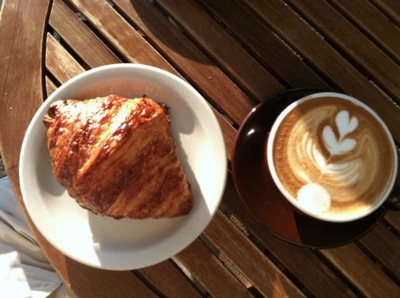Ashland, Oregon; Eastside Road, September 14, 2011—
 BREAKFAST AND LUNCH from the same place, but a hundred miles apart. Breakfast was just about my favorite: croissant and cappuccino. The croissant doesn't look quite traditional: for one thing, it's not crescent-shaped, as you see. But in every other way it's about as good as they get in this country: buttery, flaky, rich, manifold. Filling, in fact.
BREAKFAST AND LUNCH from the same place, but a hundred miles apart. Breakfast was just about my favorite: croissant and cappuccino. The croissant doesn't look quite traditional: for one thing, it's not crescent-shaped, as you see. But in every other way it's about as good as they get in this country: buttery, flaky, rich, manifold. Filling, in fact.And my daughter taught me that when a cappuccino seems, well, a little too bitter, or even sour; it may be that's my fault for having ordered it with nonfat milk. At home I roast my coffee to suit that nonfat taste; it's too much to expect that on the road. Just as a properly roasted and extracted espresso requires sugar, so does that same espresso, converted to a cappuccino, require some butterfat in its milk. This is certainly true of Stumptown coffee, and I'll henceforth bear it in mind. It was a lovely breakfast.
Lunch was taken at a roadside rest area south of Anderson: a perfect Parisian-style ham sandwich. In other words, a flûte — a thin baguette, you might say — cut in half lengthwise, nicely buttered, and filled with thin slices of boiled ham. No mustard, no mayo, no lettuce, no tomato: bread, butter, ham.
It might have been nice to have a cornichon or two on the side, but this was a sandwich packaged “to go,“ so that might have been inappropriate. In any case, truly authentic, very tasty. Really nice bread, too.
(Dinner was a slice of toast rubbed with garlic, dribbled with olive oil, and salted; half a cantaloupe afterward. Ça suffit.)
• Mix, 57 N. Main Street, Ashland, Oregon; (541) 488-9885
2 comments:
I'm not sure there is a universally accepted philosophy regarding espresso. I've always thought the first sip from the frothy head to a fresh espresso contains the best flavor, and that subsequent sips of the dark liquid become increasingly bitter.
Yet I've read experts who tell us that the froth is NOT the part that's to be savored, that it's the dark liquid underneath.
It may be that the correct way to drink an espresso is bottoms-up, the whole thing in one continuous gulp--so the flavors of the top and bottom mix in the mouth. As long as it's not too hot.
I've always thought that purists disdained putting sugar into an espresso, but I will occasionally do it if I'm drinking it slowly, using more as it becomes more bitter down to the dregs.
Cesar's--and Dopo--used to serve a small cafe americano which was as dense as an espresso. Wow!
I have an old brass and copper espresso maker which I haven't used in years. The problem was in maintaining enough pressure in the chamber to steam the half and half. I was always ginger about letting that build up too high.
What do you think about the froth question?
For cafe au laits, I think you have to use cream--or half and half--to get the full effect. Fanny's uses a thick version which may be close to whipping cream grade. Then it must be properly stirred, and stirred again (because it separates if you don't).
My friend Bob Grenier doesn't have a steamer, so he heats his milk up and then puts it in the blender to produce an imitation foam. Not too good.
As usual, much food for discussion here. In general when I have an espresso I drink it quickly; it wouldn't occur to me to taste foam and body separately.
I never used to put sugar in espresso, because I prefer my (thenceto) ordinary, American-style coffee without it. Years ago, though, Carlo, who owns Mr Espresso, told me that the espresso roast is taste-engineered to be taken with sugar, and I've noticed that most Italians take it so. We joined those ranks years ago.
Espresso drinks with milk rarely need sugar; the foamed milk supplies enough sweetening. I would never foam anything heavier than regular milk for my cappuccino or macchiato, nor have I ever seen cream or half-and-half used in a café. Ditto for cafe au lait, which needs only heated milk to complement the coffee.
Café Fanny uses Clover organic whole milk.
We have an old Faemina espresso machine; its head of steam does a pretty good job of foaming the milk. Since we use nonfat milk, though, I've never mastered the trick of foaming it so that it will make a pretty design atop my cappuccino. Various granddaughters can do this: but then, they're professional baristas. They haven't been able to teach me; nor has my Czech-born engineer son-in-law, whose cappuccinos are works of art.
If you can't produce foamed milk with live steam, as I do, the only alternative I've found to work is to heat the milk good and hot (but not too hot), then whisk it briskly with a whisk. A blender would be too violent, I think.
Post a Comment